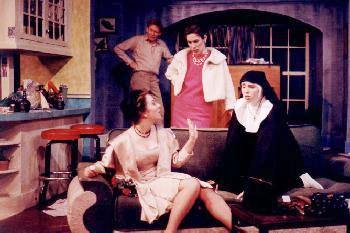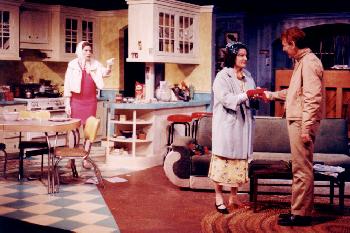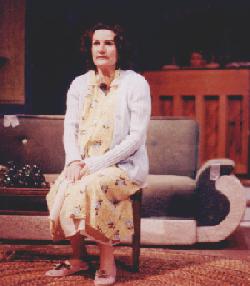The House of Blue Leaves
North Coast Repertory Theatre, Eureka CA, March 1998
These photos are the property of Patrick Spike, please do not duplicate, download, copy or print without expressed permission. Thank you.
Of Note:
"Patrick Spike has broken all records with his directing debut at NCRT. The details of Spike's direction can be seen, or not seen, throughout the entire piece. His pacing and staging draws in on the character's objectives while urging this show on to greatness. This production's quality of excellence stamp doesn't just stop with the cast and director..."
- Brenda Bishop, The Times-Standard
"In my year as Theatre Manager I have never received so much feedback about a play and its director. People phoned, wrote and stopped me on the street to say how professional the production was. [They] could see Patrick's vision and direction. At our recent Board of Directors meeting, several members said it was one of our finest productions ever. ...Patrick made it all possible."
- Meeka Day, Theatre Manger
Voted - Outstanding Director (Patrick Spike) - Beti Trauth, "Beti's Best" - Humboldt Beacon
Concept Statement, The House of Blue Leaves - updated March 13, 1999
Introduction
This is a show I’d wanted to direct for many years. Truly, it is one of my favorite plays. I love the juxtaposition of humor with pain and pathos, and how this script invites us to look into the lives of its quirky characters and see what we are perceptive enough to see. It directly challenges the sensibilities of the audience members by setting us up to take a fall. If we are sensitive enough to see the pain that lies behind these characters' ridiculous humor, then the final moments of the show become a logical and thoughtful conclusion. But if we do not see behind the humor, if we are insensitive to what is really going on in this play, then the final action becomes a shocking slap in the face, a brutal wake-up call to the plight of the desperate members of our society.
Concept & Goals - (as distributed to the design team at our first production meeting)
THEME: "Why do my dreams, which should be the best part of me,
why do my dreams, my wants, constantly humiliate me?"
- John Guare, from his forward to the play.
1) Vision Statement
a) Overall quality: This production must call to mind folks that we know, or folks that we are. We must identify with these people, despite the decidedly New York flavor of the script, so that we can see ourselves and our loved ones in them. We are in a world of borderline farce where reality is pushed off balance.
b) Stage world: This is a world where anything can happen, where the visit of the Pope means magic is in the air and the stars may line up to grant your deepest wish. Chaos and mayhem lead to insight into these people, yet they don’t see it themselves. We are looking into the fishbowl and they look out at our friendly faces.
c) Cast: (See pages 4 and 5 of script)
Artie: Middle aged, blue collar, hardened but still able to be awestruck and still has his dreams.
Ronnie: 20’s or so, hardened by the military but still with a glimmer of childlike innocence and charm. A large manic streak.
Bunny: Feminine exterior but tough as nails inside. She will fight for what she wants. In control and fast to act.
Bananas: Artie’s wife. Somewhat disturbed and a bit off center. The pills Artie gives her don’t let her ‘feel’, but instead we feel for her. She is sweet, simple, harmless, fragile, but with her own toughness and ability to fight.
Corrina: Very chic, trendy, but also insecure and tender. She hides her flaws with tenacity.
Billy: Slick, very much the LA convert from NY. He can talk big and play the tycoon, but he’s still got roots in NY.
Head Nun: Tough as nails. In another life she was a truck driver. Can manipulate in an instant.
2nd Nun: Head nun in training… her almost worthy adversary
Lil Nun: Sweet, kind, but like an annoying child at times, mostly sweet.
MP: Just what we think of an MP
White man: Gum chewing flunky sent to put the funny coat on Bananas. Just doing his job.
d) Concept Metaphor:
"The El Dorado Apartments and the main street of Jackson Heights, a Tudor-topped building with pizza slices for sale beneath it, and discount radios and discount drugs and discount records and the Chippendale-paneled elevator in the apartment building that continuously goes up and down, endlessly cycling, now creaking with age, is all carved up with ‘Love to Fuck’ that no amount of polishing can ever erase." - taken from John Guare’s forward to the play and enhanced.
e) Design: It must be comfortable, welcoming, though somewhat disheveled and trashy. As Guare tells us in the script, "Even though Artie and his family have lived here 18 years now, there is still an air of transience to the room as if they had never unpacked from the time they moved in." This is a place that all the characters still plan to get out of. It is comfortable, lived in, yet still a cage. We should feel the sense that these people are being surrounded, engulfed by this bedroom community of Queens and that it won’t let them go. It is a constant reminder of their failures. Costumes should show us either how the characters relate to their dreams, or what they are fighting for.
Challenges and Approach
This is an extremely challenging play to do correctly. As I’ve indicated above, it walks a fine line between farcical humor and tragic pathos. Additionally, it requires more energy, drive and stamina of action and characterization than I had seen from the actors in this local area. Based on these two things, I chose to emphasize the comedy in my direction of this production. The last thing I wanted was for the actors to play the material too heavily or tragically. Instead I wanted them to play against that emotion, thereby making the pain and tragedy of the piece rise up through the humor naturally and in a layered or more accumulated way. Additionally, I worked details to the extreme, due to what I see as a tendency of actors and directors in this area to not pay enough attention to detail. I felt that by emphasizing it, the actors and design team would quickly learn how much homework they were facing and also get inspired to explore more details on their own.
Outcome
Ultimately the above techniques, in my opinion, worked beautifully. I am extremely proud of this production as well as the individuals I worked with. Again, I had one actor who became a very large problem in petty power struggles with the Stage Manager and other actors, but aside from that difficulty, the production was very successful and satisfying. Sales of the show were far above expectations and the show literally became "the buzz" around town. Thematically the show had the desired effect, shocking and surprising many people who thought the ending "should be re-written." However, even those audience members greatly enjoyed the production for what they got out of it. For those who were able to see the layers in the play, it was a remarkably moving experience for them, and not soon forgotten.
"Patrick Spike has broken all records with his directing debut at NCRT. The details of Spike's direction can be seen, or not seen, throughout the entire piece. His pacing and staging draws in on the character's objectives while urging this show on to greatness. This production's quality of excellence stamp doesn't just stop with the cast and director..."
- Brenda Bishop, The Times-Standard
"In my year as Theatre Manager I have never received so much feedback about a play and its director. People phoned, wrote and stopped me on the street to say how professional the production was. [They] could see Patrick's vision and direction. At our recent Board of Directors meeting, several members said it was one of our finest productions ever. ...Patrick made it all possible."
- Meeka Day, Theatre Manger
Voted - Outstanding Director (Patrick Spike) - Beti Trauth, "Beti's Best" - Humboldt Beacon
Concept Statement, The House of Blue Leaves - updated March 13, 1999
Introduction
This is a show I’d wanted to direct for many years. Truly, it is one of my favorite plays. I love the juxtaposition of humor with pain and pathos, and how this script invites us to look into the lives of its quirky characters and see what we are perceptive enough to see. It directly challenges the sensibilities of the audience members by setting us up to take a fall. If we are sensitive enough to see the pain that lies behind these characters' ridiculous humor, then the final moments of the show become a logical and thoughtful conclusion. But if we do not see behind the humor, if we are insensitive to what is really going on in this play, then the final action becomes a shocking slap in the face, a brutal wake-up call to the plight of the desperate members of our society.
Concept & Goals - (as distributed to the design team at our first production meeting)
THEME: "Why do my dreams, which should be the best part of me,
why do my dreams, my wants, constantly humiliate me?"
- John Guare, from his forward to the play.
1) Vision Statement
- This production will explore the ridiculous, humorous and desperate ways in which we pursue our dreams and goals and ultimately how those dreams humiliate us. And then, how we attempt to cope with that humiliation and avoid more of the same.
- We follow Artie through his interactions with the people in his life and watch as the coping mechanisms fall into or out of place. We watch the characters attempt to make changes in their lives, how they work to improve their situations, how they plan for a perfect day, and realize even before they do that that perfection, that bright day will never arrive.
Audience Journey: The members of the audience first encounter Artie in performance of his songs. Perhaps this is a dream, or did he really perform at the club? We then meet the other characters, little by little learning the relationships and the odd ways in which they intertwine. What is the Bunny's history? What is the relationship with Bananas and just how "bananas" is she, or isn’t she? As the bizarre and twisted history of these characters unfolds, the audience comes to understand their eccentricities as well as their desires and defenses. We laugh at their foibles, at their trials, at their dilemmas, and in the end we weep for their pain. When all is said and done, Artie is left with Bananas, finally alone, and we watch as their only choices, their desperate choices, lay bare their ultimate fears.
a) Overall quality: This production must call to mind folks that we know, or folks that we are. We must identify with these people, despite the decidedly New York flavor of the script, so that we can see ourselves and our loved ones in them. We are in a world of borderline farce where reality is pushed off balance.
b) Stage world: This is a world where anything can happen, where the visit of the Pope means magic is in the air and the stars may line up to grant your deepest wish. Chaos and mayhem lead to insight into these people, yet they don’t see it themselves. We are looking into the fishbowl and they look out at our friendly faces.
c) Cast: (See pages 4 and 5 of script)
Artie: Middle aged, blue collar, hardened but still able to be awestruck and still has his dreams.
Ronnie: 20’s or so, hardened by the military but still with a glimmer of childlike innocence and charm. A large manic streak.
Bunny: Feminine exterior but tough as nails inside. She will fight for what she wants. In control and fast to act.
Bananas: Artie’s wife. Somewhat disturbed and a bit off center. The pills Artie gives her don’t let her ‘feel’, but instead we feel for her. She is sweet, simple, harmless, fragile, but with her own toughness and ability to fight.
Corrina: Very chic, trendy, but also insecure and tender. She hides her flaws with tenacity.
Billy: Slick, very much the LA convert from NY. He can talk big and play the tycoon, but he’s still got roots in NY.
Head Nun: Tough as nails. In another life she was a truck driver. Can manipulate in an instant.
2nd Nun: Head nun in training… her almost worthy adversary
Lil Nun: Sweet, kind, but like an annoying child at times, mostly sweet.
MP: Just what we think of an MP
White man: Gum chewing flunky sent to put the funny coat on Bananas. Just doing his job.
d) Concept Metaphor:
"The El Dorado Apartments and the main street of Jackson Heights, a Tudor-topped building with pizza slices for sale beneath it, and discount radios and discount drugs and discount records and the Chippendale-paneled elevator in the apartment building that continuously goes up and down, endlessly cycling, now creaking with age, is all carved up with ‘Love to Fuck’ that no amount of polishing can ever erase." - taken from John Guare’s forward to the play and enhanced.
e) Design: It must be comfortable, welcoming, though somewhat disheveled and trashy. As Guare tells us in the script, "Even though Artie and his family have lived here 18 years now, there is still an air of transience to the room as if they had never unpacked from the time they moved in." This is a place that all the characters still plan to get out of. It is comfortable, lived in, yet still a cage. We should feel the sense that these people are being surrounded, engulfed by this bedroom community of Queens and that it won’t let them go. It is a constant reminder of their failures. Costumes should show us either how the characters relate to their dreams, or what they are fighting for.
Challenges and Approach
This is an extremely challenging play to do correctly. As I’ve indicated above, it walks a fine line between farcical humor and tragic pathos. Additionally, it requires more energy, drive and stamina of action and characterization than I had seen from the actors in this local area. Based on these two things, I chose to emphasize the comedy in my direction of this production. The last thing I wanted was for the actors to play the material too heavily or tragically. Instead I wanted them to play against that emotion, thereby making the pain and tragedy of the piece rise up through the humor naturally and in a layered or more accumulated way. Additionally, I worked details to the extreme, due to what I see as a tendency of actors and directors in this area to not pay enough attention to detail. I felt that by emphasizing it, the actors and design team would quickly learn how much homework they were facing and also get inspired to explore more details on their own.
Outcome
Ultimately the above techniques, in my opinion, worked beautifully. I am extremely proud of this production as well as the individuals I worked with. Again, I had one actor who became a very large problem in petty power struggles with the Stage Manager and other actors, but aside from that difficulty, the production was very successful and satisfying. Sales of the show were far above expectations and the show literally became "the buzz" around town. Thematically the show had the desired effect, shocking and surprising many people who thought the ending "should be re-written." However, even those audience members greatly enjoyed the production for what they got out of it. For those who were able to see the layers in the play, it was a remarkably moving experience for them, and not soon forgotten.










